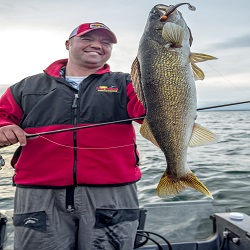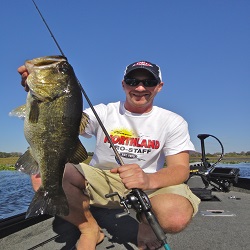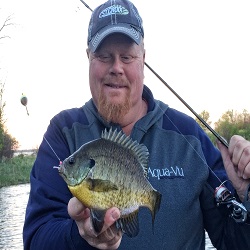Northland Fishing Tackle pros provide summer fishing tips on how to catch walleye, bass, and bluegills right now in the Midwest.
As we move into May, the underwater world of Midwestern fish mirrors the newly-emerging grasses and leaves sprouting on dry land. It’s a time of renewal, when fish and prey seek places of warming temperatures, and, in many cases, where they will spawn. Weather can flip-flop, and fish can be pre-spawn, spawn, or post-spawn, making this a challenging time as we seek walleyes, bass, and bluegills.
Ride with the fish on the tides of May and stay with ‘em into June, by following these recipes from Northland pros Tony Roach, Jeff “Gussy” Gustafson, and Brian “Bro” Brosdahl.

Rip and swim for early walleyes:
Tony Roach
Many early-season walleyes spend time in shallow water, even before weeds become the reliable cover. They might be along windswept shorelines, over sand, gravel, even beds of bottom-hugging sand grass. They might be in a foot of water, or into the middle depths.
“You have to cover a lot of water,” says veteran guide Tony Roach, “to find shallow walleyes. Here are a couple of my favorite ways to catch ‘em.”
• Rig up a swimming jig head with a plastic tail perfect for swimming or dragging.
“My favorite is the Slurp! Jig,” says Roach. “I use lighter jigs early in the season, before the weeds are really up, and do more pitching, popping, and dragging along the bottom. As we get taller weeds, I use a heavier jig, so I can pitch into pockets and rip the bait through them. I use a braided line with a fluorocarbon leader. If you snag a weed, pop it hard and it falls off most of the time.”
Favorite plastics for this: Impulse Paddle Minnow
• The swiveling minnow trick is also deadly.
Roach has another trick that takes full advantage of a swiveling jig head and plastic minnow body, to accurately mimic a baitfish poofing along the bottom and tipping it down to feed.
“Walleyes love to pick things up off the bottom,” he says. “What I do is take a 3-inch Impulse Smelt Minnow or Impulse Live Paddle Minnow, and rig it to the Swivel-Head Jig. It has an articulating head, and the plastic actually sits upright.
“I pitch it out, rip it, let it momentarily hit bottom, rip it again, let it hit bottom, and just keep going like that. Every time it settles to the bottom, it kicks up a cloud and the plastic minnow looks like it’s rooting around on the bottom. It’s lights out as a walleye bait.”

Checking cover for early bass:
Jeff ‘Gussy’ Gustafson
Touring FLW bass pro Jeff Gustafson is also a longtime guide and offers up his go-to approach for big bass in May and June.
“At this time of year,” says Gussy, “most bass are in or close to spawning habitat. Largemouths like to spawn in the backs of bays and other protected areas. Key on the north side of the lake, looking for shallow water that’s a bit warmer. Look for cover they can hold on to, like laydown trees, clumps of pencil reeds, or bulrushes. Could be docks.”
If bass are pre-spawn or post-spawn, “they’re probably hanging on the cover that’s on the way in or out of that back-bay, shallow stuff,” Gustafson notes. “Use your eyes. Do you see bass on beds, or are they a bit deeper, on the next level out from the spawning areas?”
Search, then pitch
To quickly search vast areas and figure out what type of cover bass are favoring, Gussy relies on a spinnerbait during the pre-spawn period. “I love the 1/2-ounce Reed-Runner,” he says, and I start by fishing everything I see. Trees, docks, bulrushes, whatever. I use white in clear water, and in dirty water, chartreuse skirt with gold blades.”
Hot tip: if bass seem lethargic, and few strikes come on the spinnerbait, suspect they are done spawning. To search for post-spawn largemouths, Gustafson chooses a wacky-rigged soft plastic stickbait. “It sinks very slowly,” he says, “so cast it past your target and slowly move it in there. It’s a bait that largemouths don’t pass up very often if it floats by them. You have to fish it slower than a spinnerbait, so take your time.”
After a pattern begins to emerge, he slows down and pitches to the winning cover type.
For this, Gussy favors a 3/8- or 5/8-ounce Jungle Jig, a bass jig with a weed guard. Using a 7 1/2-foot rod and 20-pound-test line, “I can pitch it into pretty much any cover and muscle the fish out.”
Gussy’s pitching secrets
Practice pitching the Jungle Jig, landing softly as possible, directly into clumps of cover. Let it fall straight to the bottom. You must let out a little slack line just as the jig hits the water; a tight line will pull the jig off the target as it sinks, also resulting in more snags.
When the jig hits bottom, shake it a couple of times, moving it no more than about 2 or 3 feet, then quickly reel it in and pitch to the next target.
“This bait selects for big fish,” says Gussy, “and most bites come within five seconds of the bait hitting the water.”

Shallower than you think for early bluegills:
Brian ‘Bro’ Brosdahl
Tracking down big bluegills is one of professional guide Brian Brosdahl’s specialties, so we forced him to spill the beans on his best recipe for May and early June.
“You have to find the warmest water in the lake,” Bro begins. “I’m generally seeking out muddy areas, typically on the north end, but that can change depending on which way the wind is blowing. And I’m looking for any kind of healthy vegetation. Boat harbors, canals, and creek areas are always good bets. Little creeks more than rivers. You don’t want heavy current flow.”
Big ‘gills, says Bro, “will be in some of the shallowest water you find, as shallow as maybe 15 inches. Good spots are often overlooked because people don’t go shallow enough.
“There will be fish in 4 to 8 feet, too, but when the sun comes out, they’re going to move up to places where the bottom is black and warm.”
Search tactic
To find bluegills, Bro ties on a 1/8-ounce Thumper Jig, with a small plastic tail (Northland makes a wide variety of panfish-size plastics). The Thumper Jig has a “belly blade” that flickers, flashes, and flutters, helping to call up fish.
“Make a short cast with it,” says Brosdahl, “and find out what speed retrieve just gets the spinner moving. Then, use that speed as you make longer casts. Every now and then, jig it a little bit, but mostly just roll that reel handle. Sometimes bluegills will just follow it, but in clear water, you can see them. You don’t have to catch ‘em to find the school.”
Time for catchin’
When you locate a pod of nice bluegills, slow down and tempt them with a small ice-fishing jig fished below a small slip-float.
Bro’s favorites for this: are the Hexi Fly (Tiger Beetle pattern) or Bro Bug (Caterpillar).
How he rigs it: braided line of about 2-pound diameter as the mainline, onto which he slides a slip-bobber knot, along with an extra sinker if needed to balance the float so it’s almost under at all times. Then a swivel, tied to a short leader of light fluorocarbon leader, length based on the depth of water being fished. Hexi Fly or Bro Bug is tied directly to the leader.
“I love the Hexi Fly with a couple of waxies, maggots, or a chunk of nightcrawler,” says Bro, “because it see-saws as it falls. Then when you jig it, even under a float, it kind of darts forward.”
How he fishes it: pitch it to a target and let it settle. “To jig it,” says Bro, “just tip the bobber over real quick, then let it settle. You’re trying to draw ‘gills into the little action, then they smell the bait and eat it.
“If that isn’t working, I like to “pop-pop” the bobber, let it settle, pop-pop again, and do that continuously on the way in. When fish come up to it, I twitch it and let it pause. Sometimes they gather around it, and the pause lets one decide to test the bait.
“When fish are right at the bait, try not to move the bobber as aggressively. You do want to keep the jig moving, though, because active baits catch big bluegills.”
This year, after the ice is gone, put your ice jigs in the boat. “Panfish are on the menu at our house all year,” says Bro, “and I’ve been using ice jigs to catch them, all year, ever since I can remember.”

